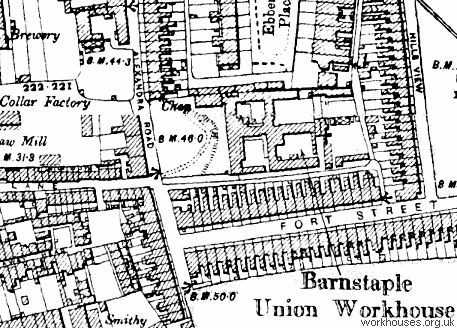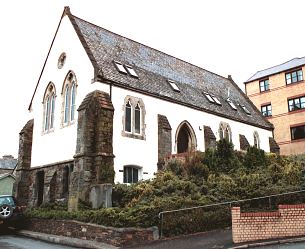Barnstaple, Devon
Up to 1834
A parish workhouse existed Ilfracombe from around 1740 (Hitchcock, 1985).
A parliamentary report of 1777 recorded parish workhouses in operation at Barnstaple (for up to 80 inmates), Ashford (12), Berryn Harbour {Berrynarbor] (12), Combe Martin (2), Heanton-punchardson [Heanton Punchardon](16), Ilfordcombe [Ilfracombe] (60), and Pilton (30).
In Combe Martin, a building on the High Street, known as Church House, which had served as a poorhouse since 1662, was converted for use as a workhouse. The building is now home to a community centre.
After 1834
Barnstaple Poor Law Union formally came into existence on 2nd December 1835. Its operation was overseen by an elected Board of Guardians, 50 in number, representing its 39 constituent parishes as listed below (figures in brackets indicate numbers of Guardians if more than one):
Devon: Ashford, Arlington, Atherington, Barnstaple (5), Berryn Arbor, Bittadon, Bishops Tawton, Braunton (2), Bratton Fleming, Brendon, Challacombe, Combe Martin (2), Countisbury, East Down, Fremington, Goodleigh, Georgeham, Heanton Punchardon, Horwood, High Bray, Ilfracombe (3), Instow, Kentisbury, Landkey, Linton, Loxhore, Marwood, Martinhoe, Morthoe, Newton Tracey, Paracombe, Pilton (2), Sherwill, Stoke Rivers, Swymbridge (2), Tawstock, Trentishoe, West Down, Westleigh.
In 1894, Pilton was divided into East Pilton and West Pilton.
The population falling within the Union at the 1831 census had been 33,198 — ranging from Bittadon (population 57) to Barnstaple itself (6,840). The average annual poor-rate expenditure for the period 1833-35 had been £33,198 or 7s.0d. per head
A new union workhouse was built in 1837 on the east side of Alexandra Road, Barnstaple. It was designed by by Sampson Kempthorne who was also the architect for other Devon workhouses at Axminster, Crediton, Exeter, Okehampton, and South Molton. Intended to accommodate 270 inmates, the Poor Law Commissioners authorised the sum of £4,800 on its construction. The workhouse location and layout are shown on the 1903 map below:

Barnstaple site, 1903
The workhouse layout was based on Kempthorne's standard cruciform or "square" design which created four courtyards — one each for men, women, boys and girls.
A large chapel was erected at the north-west corner of the workhouse. This is now all that survives of the building.

Barnstaple chapel from the south-west, 2001.
© Peter Higginbotham.
From 1904, to protect them from disadvantage in later life, the birth certificates for those born in the workhouse gave its address just as 19 Alexandra Road, Barnstaple.
In 1930, the site was taken over by Devon County Council and became a Poor Law Institution. From around 1933, it was used to accommodate 'mentally defective' inmates. It joined the National Health Service as Alexandra Hospital, finally closing in 1978.
Cottage Homes
In the early 1900s, the union established a group of thee children's cottage homes near to the workhouse on Alexandra Road, Barnstaple. The homes could accommodate a total of 50 children.
Staff
Inmates
Records
Note: many repositories impose a closure period of up to 100 years for records identifying individuals. Before travelling a long distance, always check that the records you want to consult will be available.
- North Devon Record Office, Tuly Street, Barnstaple, EX31 1EL. Relatively few local records survive — holdings include: Guardians' minute books (1855-1927, with gaps); Collector's receipts and payments (1845-1950); etc.
Bibliography
- Hitchcock, T.V. (1985) The English workhouse: a study in institutional poor relief in selected counties. l695-l750. (DPhil thesis. University of Oxford.)
Links
- None.
Unless otherwise indicated, this page () is copyright Peter Higginbotham. Contents may not be reproduced without permission.


